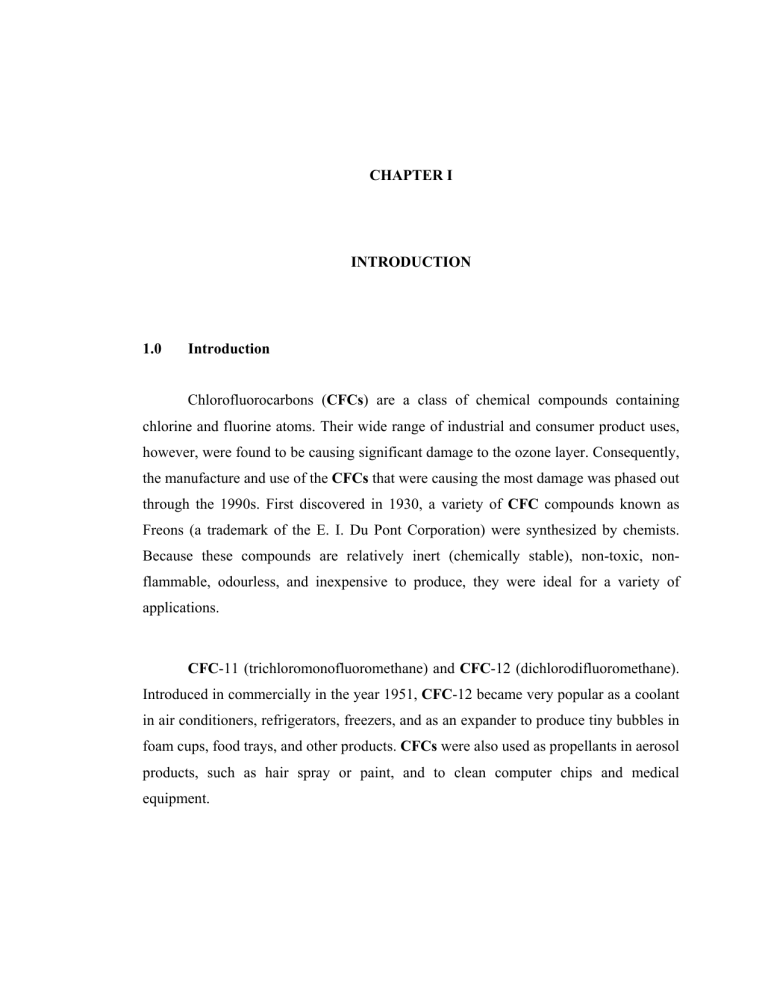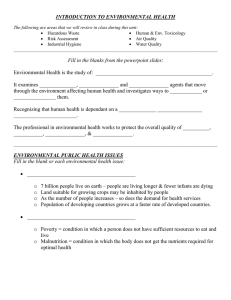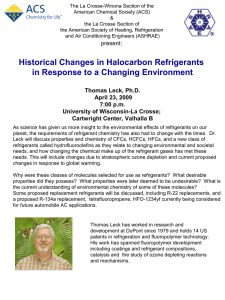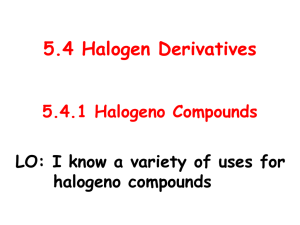CHAPTER I INTRODUCTION 1.0 Introduction

CHAPTER I
INTRODUCTION
1.0 Introduction
Chlorofluorocarbons ( CFCs ) are a class of chemical compounds containing chlorine and fluorine atoms. Their wide range of industrial and consumer product uses, however, were found to be causing significant damage to the ozone layer. Consequently, the manufacture and use of the CFCs that were causing the most damage was phased out through the 1990s. First discovered in 1930, a variety of CFC compounds known as
Freons (a trademark of the E. I. Du Pont Corporation) were synthesized by chemists.
Because these compounds are relatively inert (chemically stable), non-toxic, nonflammable, odourless, and inexpensive to produce, they were ideal for a variety of applications.
CFC -11 (trichloromonofluoromethane) and CFC -12 (dichlorodifluoromethane).
Introduced in commercially in the year 1951, CFC -12 became very popular as a coolant in air conditioners, refrigerators, freezers, and as an expander to produce tiny bubbles in foam cups, food trays, and other products. CFCs were also used as propellants in aerosol products, such as hair spray or paint, and to clean computer chips and medical equipment.
2
1.1 Ozone depleting and global warming effects
The threat of ozone depletion and global warming is of very serious concern to mankind. Most refrigerants in use today contribute significantly to either or both of the effects. However, quantifying their effects is a difficult exercise with at least three main approaches; the Ozone Depletion Potential (ODP), Global Warming Potential (GWP), and Total Equivalent Warming Impact (TEWI). All of which is described by some numerical values based on some reference states. The computations of these indexes are complex and involve a large number of analytical, experimental and empirical data inputs. The practice will continue as more developed and sophisticated models are introduced. The numbers associated with each approach are continuously being revised with the availability of more data.
1.1.1 Ozone depleting effect
The presence of the ozone layer prevents the UV radiation from reaching the earth. The ozone depleting effect involves the reduction and/or removal of this thin layer, allowing the harmful UV radiation to reach the crops and the phyto-plankton of the oceans. Life on earth depends either directly on indirectly on these minute organisms with some of the consequences being an increase in the incidents of skin cancer, cataracts and impairment of the body's immune system. [17]
Both CFCs and halons (related chemicals which contain bromine) are chemically stable and can persist for many years in the atmosphere. Their eventual breakdown in the stratosphere releases halogens, with the CFCs releasing chlorine and the halons releasing bromine. These halogens break down the ozone layer without being destroyed. Thus, one halogen atom can breakdown thousands of molecules of ozone before it is finally removed from the atmosphere. The extent of the destruction very much depends on the type (Cl
2
or/and Br
2
) and number of halogens being released, and its residence time in the atmosphere. A relative index, ODP, is assigned to a substance indicating the extent
3 to which it may cause ozone depletion, with CFC 11 used as the reference point having a value of 1. A substance with a given weight, having an ODP of 0.5 would mean that it would deplete half the ozone that the same weight of CFC 11 would.
1.1.2 Global Warming Effect
The global warming effect is the increased in the earth’s temperature which is brought about by the absorption of long wave radiation by various gases present in the troposphere. The layer extends to about 15 km over the earth’s surface with the gases behaving as an insulator. Under normal circumstances, the warming up effect raised the earth’s temperature from as low as –18 o C to acceptable living conditions. Natural concentrations of C0
2
and H
2
0 actually keep up the balance. However, a fraction change in this effect can significantly influence the wind flow pattern and subsequently the weather conditions. Continuous heating up of the earth’s surface may have caused the increase in sea level and the melting of the ice caps. The extent of effects is described with the index GWP [17].
A refrigeration system releasing molecules of CFSs may have adverse long term effects on the environment depending on the length of time it stays in the atmosphere.
The index GWP for different gases is based on C0
2
with R11 sometimes used as the reference gas. Since each has a GWP value of unity, it is important to mention the reference gas when using GWPs.
1.1.3 Total equivalent warming index
Another approach to describing the effects of CFCs is the concept of Total
Equivalent Warming Index (TEWI). This last method involves the energy consumption of the equipment during its operation, which may also contribute to global warming. The
4 amount and type of blowing agent used in the insulation, the energy consumption over the system expected lifetime, and the contributions from the refrigerant itself are factors that must be taken into account. [17].
1.2 Background
Molina and Rowlands (1974) maintained that CFCs UV radiation in the stratosphere principally destroyed the ozone layer. The chlorine released in the high stratosphere encouraged the decomposition of ozone to oxygen allowing UV radiation to penetrate to lower altitudes. A constant CFC emission of 700,000 tonnes per year can deplete up to 3% of the ozone layer after a hundred years (Ho Man, 1987).
Starting from the mid seventies through the eighties, scientists have discovered an alarming decrease in ozone over Antarctica and Arctic during the winter months. The so-called ozone holes over both poles, which grew larger each year, were linked to
CFCs released into the atmosphere. The CFCs slowly diffused into the stratosphere
(upper atmosphere) and get partially broken down by sunlight releasing free radicals in the process. Studies have proven that these free radicals react with ozone.
The danger posed by CFCs had many countries, among them the United States,
Sweden, Finland, Norway, and Canada, banning the use of CFC -11 in spray cans in the late 1970s. Then in September 1987, 24 developed nations signed the Montreal Protocol to cut production of five CFCs with additional agreements signed between 1990 and
2000. CFCs have been replaced by less stable CFC compounds and by non-CFC chemicals, which break down before they reach the stratosphere.
Puong, et al (1987) found that among the R21-DMETEG, R21-DMF, R22-
DMETEG, and R22-DMF of fluorocarbon refrigerant, R21-DMETEG stands out as the most suitable solution for low temperature vapour absorption heat pump (VAHP) applications. Correlations are given for a quick estimation of COP and limiting generator
5 temperature. The performance characteristics compared are total heat output per unit solution flow rate, heating coefficient of performance (COP h
), second low efficiency and circulation ratio.
Vincent L. DiFiliippo (1989) illustrated HFC- 134a as a replacement for CFC-12 with a technical overview of converting reciprocating air conditioning and refrigeration systems to HFC-134a. Their study summarized HFC-134a land based and shipboard test results, as well as expanded on the technical developments experienced during the implementation process.
Wen-Lu Weng and Bin-Chang Huang (1995) used the Iwai-Margerum-Lu equation of state in their study of the thermodynamics performances of a variety of fluid circulating in an ideal heat pump cycle. Their evaluations were implemented at three operating conditions. Their result showed that the normal boiling point and the critical pressure of compounds are the key properties for selecting the thermodynamically proper working fluids. Several potential non-CFC compounds were suggested for the heat pumps with respect to each application depending on the compressor type.
I. L. Maclaine-cross and E. Leonardi (1995) in their paper mentioned that initially R290 could replace R22 while LPG mixtures can replace R12 and R134a. The halogen free refrigerant (R600a) gives the highest value of COP compared with other refrigerants such as RC270, R12 and R134a. The market for R600a grew as new equipment exploits the advantages of its lower vapour pressure . The refrigerant has half the leakage, pressure loss, condenser pressure, and twice the heat transfer properties of
R12 and R134a. Energy consumption savings is also achieved with R600a refrigeration systems.
S.M.Sami and P.J.Tulej,(1995) studied the comparative performance of ternary blends proposed as substitution for CFC-12. An experiment to evaluate the blend performance was set up, which includes a domestic refrigerator. The ternary blend
6
NARM-12 was found to consume 35% less energy than CFC-12, and exhibits shorter cycles at comparable pressure ratios than CFC-12.
A. Stegou, (1996) in his study of the thermodynamic properties formulations and heat transfer aspects for replacement refrigerant - R-123 and R-134a - stressed about analytical relations for the thermodynamic properties, enthalpy, entropy, and heat capacities at constant pressure and temperature of the replacement refrigerants R-123 and R-134a. The isentropic change in the particular fluids was also studied and a set of graphs were plotted to illustrate the dependence of these exponents on the pressure and temperature. The results are useful in efforts to improve the basic design as new refrigerants are being considered to replace the CFCs refrigerant.
S.B. et al (1996) presented a review of the application of the main natural refrigerants for refrigeration and air conditioning systems as an alternative to synthetic new refrigerants (HFCs). The natural working fluids that have been studied are Air,
H
2
O, CO
2
, NH
4
, Hydrocarbons and etc. Their result showed the hydrocarbons give the better COP compared of CFCs refrigerant.
D. T. Ray, et al (1997) developed correlations for CFC-114 and HFC-236ea. The model was tested for a range of inlet condenser water temperatures and evaporator loads.
The results are presented and compared with data provided by the Naval Surface
Warfare Center (NSWC) in Annapolis, MD. Several recommendations to further improve the performance of HFC-236ea in Navy chillers were given. They include adjusting the load of the evaporator to achieve positive gauge pressure, use of a purge device, use of a variable speed compressor, further testing with azeotropic mixtures, and use of high performance tubes in the heat exchangers. The results yield additional insight as to the possible suitability of HFC-236ea as a drop-in substitute for CFC-114.
According to C. Aprea, et al (2002) found that the best results of the exergy analysis have been obtained using R22 followed by non-azeotropic substances. R22 performance was found to be consistently better than that of its candidate substitute, the
7 non-azeotropic mixture R407C. The difference stems from the different irreversibilities of the plant components arising when using R22 and R407C, respectively. Specific attention is devoted to compressor irreversibilities. Performance indices related to the semi-hermetic compressor are evaluated when using either refrigerant.
It is widely accepted that alternative refrigerants must replace the CFCs with equal if not better performance and efficiency. This study will determine the non-CFC refrigerants performance in terms of 1 st and 2 nd law of thermodynamics depending on the refrigerant types. The useful properties of some HCFCs, HFCs and industrial organic refrigerants in the industry will be compiled in an accessible way and their performance in some systems simulated. A software that can determine the performance of the refrigerants and their potential replacement counterparts for a quick evaluation. The package will help industries associated with the use of refrigerants in general to have a better understanding of the system with the replacements. Local industries in particular will be encouraged in the transition to environmentally friendly refrigerant by using locally made software.




